A priest friend and I are headed to SW Wisconsin to visit churches built by the Dominican missionary Ven Samuel Mazzucchelli.
We will aim at Dubuque to see the Cathedral. The founder, Bp Loras was a friend of St John Vianney.
Meanwhile it is a picture perfect summer day.
More later.
UPDATE:
It’s later.
We stopped in Darlington (really charming Darlington). There was an amazing county seat building and civil war monument.
On to Schullsburg to see a parish founded by Ven. SM.
Ven. SM named the streets in the town around the parish, which is at the corner of Truth and Judgment.
Then on to New Diggings. This area had lead mines. This little church, St. Augustine’s, was built by the Venerable.
It remains today as it was in his day.
On to Benton to see the grave of the Venerable.
Then it was on to Dubuque where we saw the cathedral. It was hard to get into. We eventually found a sign directing us to the rectory, where we were met with indifference but, nevertheless, led to the church. No males in sight, btw. No lights were turned on for us and we were told to find our way out. Thus, we didn’t get a chance to visit the crypt.
It was then on to Sinsinawa Mound to see some of the items that belonged to Ven. Samuel, the founder of this group of Dominicans. This is a super liberal group.
This was in the parking lot next to our car.
The inside of their chapel. Look at the vast number of places in the choir stalls. This was built, if I recall, in 1964.
You should be able to click the image, below, for a large version.
On our way to see an exhibit about the Venerable, we saw this helpful sign, which must have been intended for use during some sort of retreat.
Here is the painting whence the image of the Venerable is copied.
A copy of a wilderness altar.
Actually, the exhibit on Fr. Mazzuchelli was pretty interesting. There were also displays about St. Clare Women’s College.
In their bookstore.
The gift store was … eclectic.
Then is was on to Fennimore to see the marvelously restored parish church, which is entrusted to the priests of the Society of Jesus the Priest.
Then it was back to Madison.
The temperature was about 80F and we had puffy white clouds and a breeze. Perfect for a drive.



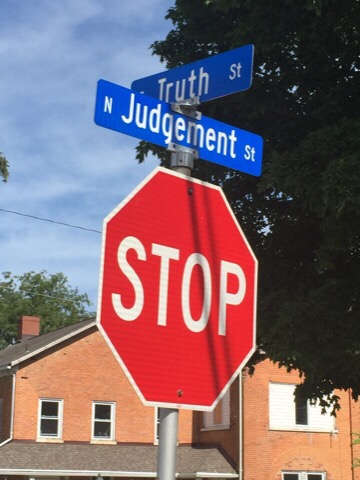
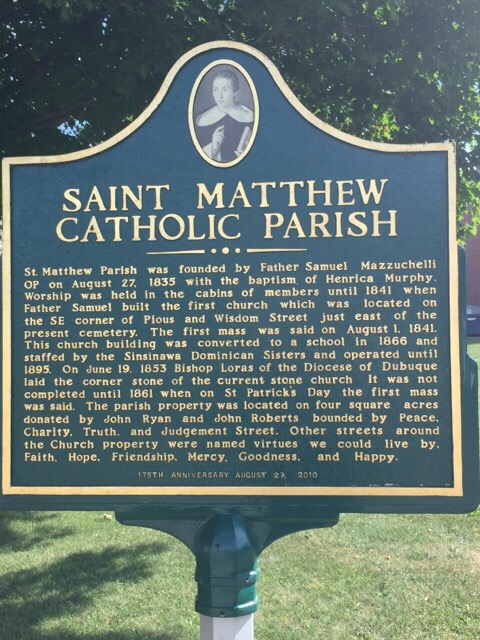
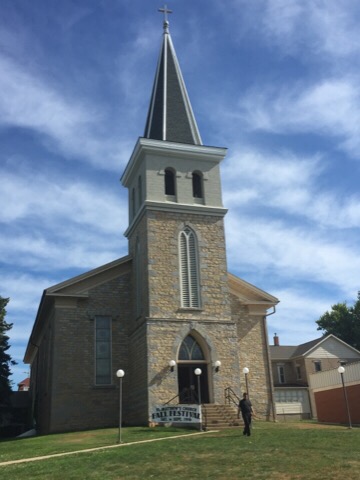

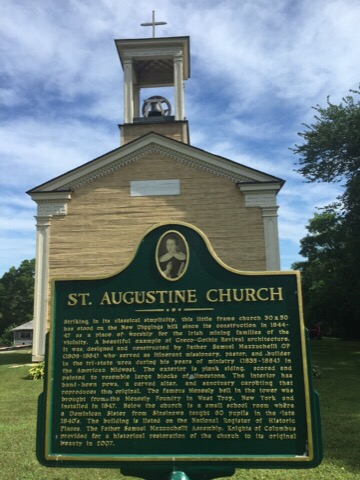
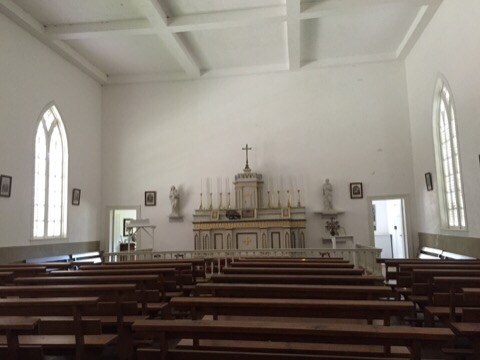

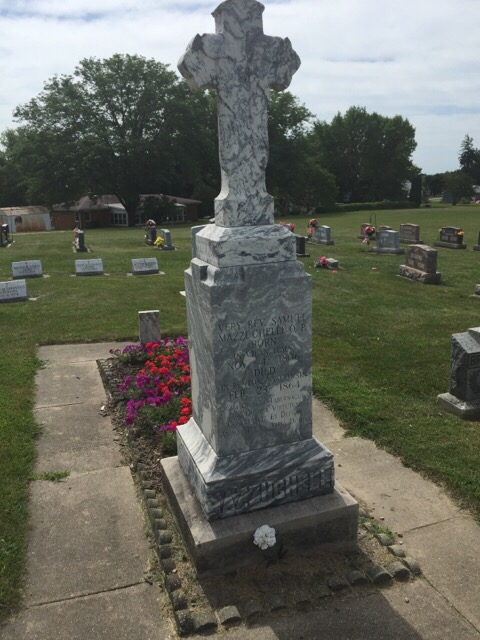
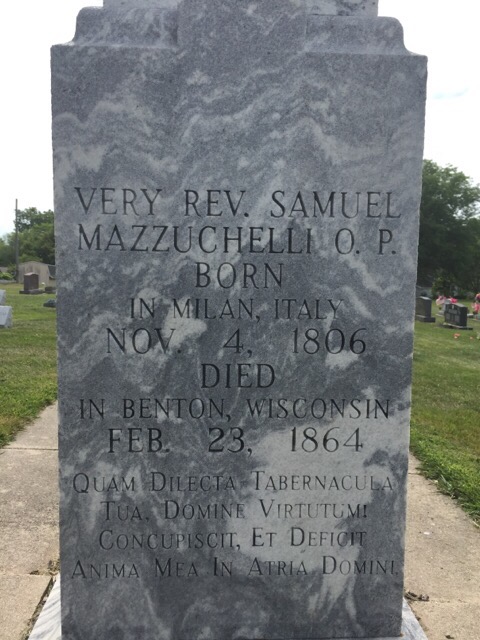

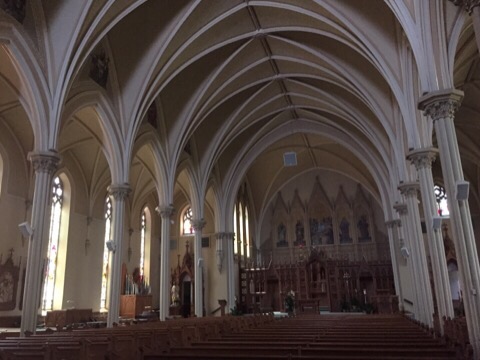
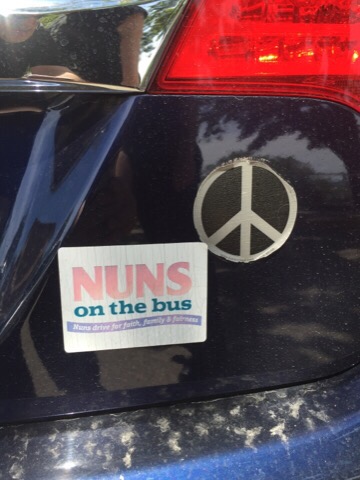


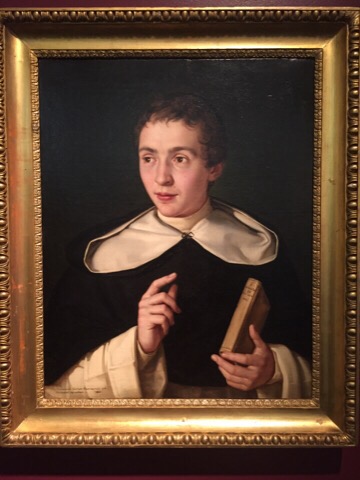
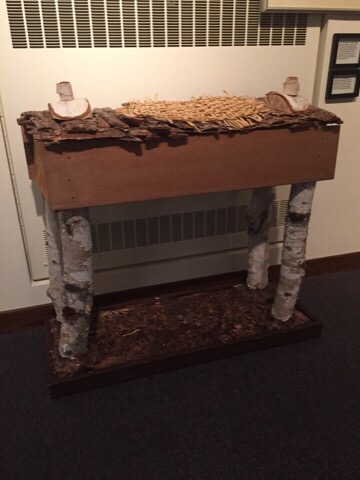



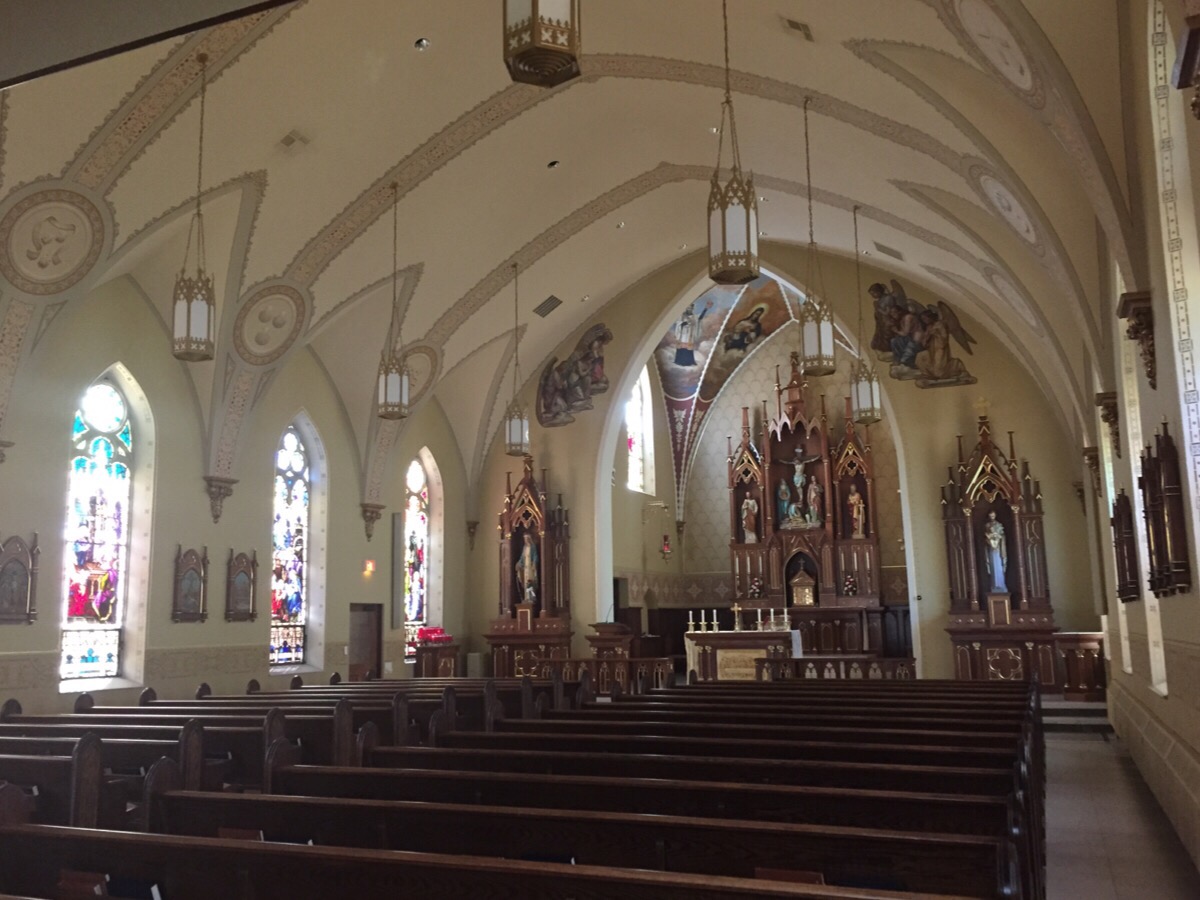

































Happy steeplechasing. I’ve seen the outside of the cathedral in Dubuque, but never been inside. I’ve read though that the “renovation” done in the 80s was not so good. :(
Padre,
I do hope you stop in Galena. Fr. Mazzucchelli was the pastor of St. Michael and built the Church thinking that it might be the Cathedral of the Illinois diocese. He also was an advisor to the building of St. Mary. Galena is a great walking town. Fritz and Frites a great place for lunch.
Fr. L
What a great idea! I approve! I have never been able to get to Dubuque, or Galena.
http://www.fathermazzuchellisociety.org
Did you choose the area to visit Fr Mazzucchelli’s churches, or to visit the quite nice breweries in the area … New Glarus, I see is on your map, and is worth the stop.
I might also note, our church happens to have a stained-glass window including Fr Mazzucchelli.
I can’t wait until we all get to Heaven one day and we can all be “a friend of St. John Vianney.” His feast day is today! On this day back in 1976 my little sisters and I were involved in a frightening car wreck. We believe St. John Vianney had a part in preserving our lives. We all grew up to have very large Catholic families. Think of all the children and grandchildren possibly saved by his intercession! May he continue to pray for us all! And God bless Fr. Z! Take pictures!!
Fr Mazzuchelli was a tremendous witness to the Sacrament of Penance. He has wonderful stories about that Sacrament in his Memoirs (I am the publisher of that edition and it is priced to be affordable, I don’t make a penny). This aspect of him is sadly minimalized in the Positio about his heroic virtue, written by a Sinsinawa Dominican sister, and in all other works about him by Sinsinawa Dominicans (the order he founded). I hope it is all right if I include some below!! Fr Mazzuchelli’s Memoirs are written by him, but modestly in the third person.
Glad you made it down to my neck of the woods. Sorry you weren’t more welcomed at the Cathedral.
When I took my friends to see the cathedral in Newark, New Jersey not too long ago, we were met with similar disappointment when, at 5 PM on a Saturday afternoon in August, only an hour before the 6 PM Mass, we attempted to gain entry and found the place locked up tight. A caretaker basically told us to go away. We had other plans for Sunday Mass the following day, so they never did get to see the inside of that grand cathedral.
Otherwise, this sounds like a trip I should perhaps duplicate one time as I pass through Wisconsin.
“At the corner of Truth and Judgement… Nuns on the bus.”
Fr. Z, pretty much everything you convey is poetry.
Fr Z that is the same Nuns on the Bus sticker I gave you! Remember the Nuns on the Bus went to Sinsinawa early in the morning the same day they went to Janesville where I met them. So fantastic,, great pictures, you really covered a lot of sites, and what a beautiful day it was today. Yes, the exhibit at Sinsinawa is really very good.
I looked up what that poster was of, something called Cynefin (there is a Wikipedia article on it but I think if I make 2 links then my comment will have to wait in the moderation queue!). While I had never heard of this, my educated guess is that this is being used to discuss change and community dynamics in their congregational decision making processes. It’s a reasonable surmise that this ties in to systems thinking.
A very quick google search finds an article from the Sinsinawa congregation magazine Spectrum that explains exactly what this is about: http://athenaplace.com/wp-content/uploads/2015/04/Sinsinawa-article-March-2015.pdf That is from the website of the professional facilitation people “Athena Group” who say they led a 4 day session for the leaders of Sinsinawa and are are going to lead a “10-day gathering” for them in April, 1015. This may mean their Chapter Meeting; as their redefinition of religious life and abandonment of their Constitutions which they cannot get a new version of approved means losing the benefit of normal means of decision making of a religious congregation, the Sinsinawa Dominicans are the hugest consumers of trendy forms of professional change discussion/decision making facilitation services. In particular “Athena Group Partner Paul Horton will work closely to help the client put a sharper focus on navigating the intricacies of the stewardship planning efforts as the committees explore the present realities and the future possibilities and opportunities of the Sinsinawa Mound, its buildings, land and mission.”
Did you visit the trippy relic room at Sinsinawa? It is in the chapel, off to the left. Their bookstore is freakish, and did you notice there is not one book from Ignatius Press! According to its Amazon page A God That Could be Real is apparently by a lifelong atheist and philosopher of science: “In A God That Could Be Real, Abrams explores a radically new way of thinking about God. She dismantles several common assumptions about God and shows why an omniscient, omnipotent God that created the universe and plans what happens is incompatible with science—but that this doesn’t preclude a God that can comfort and empower us.” I sadly assure you, this is plausibly within the spectrum of diverse beliefs about God held by Sinsinawa Dominicans.
https://en.wikipedia.org/wiki/St._Anthony%27s_Catholic_Church_(Davenport,_Iowa)
Venerable Samuel Charles Mazzuchelli was also the founder of my own home town parish where I attended Mass in 2008, and for the past three months until last week. This world is very, very small.
Also, when I was a grad student at ND, one of my roommates, as I lived with four nuns, of different orders, was a Sinsinawa Dominican. The nuns were lib then. I remember clearly a discussion on a hot summer’s Saturday in our grad townhouse when the Franciscan, the Mercy, and the Dominican nuns were complaining about no vocation. This was in 1983. I said “Look at you. You have more money for entertainment than the average grad woman student. Your wear expensive cloths and top of the market running shoes. You belong to fitness clubs, and you all have cars with expense accounts. You are not living the Gospel and you are not signs of contradiction in the world.”
They all stomped away angry, but later, the Sinsinawan came back and said I was correct. God bless her.
Years ago, they sold off tons of valuable relics, statues, Latin Rite rare vestments, etc, in an infamous auction.
The past glory of the Catholic Church in the Midwest is past. I shall not go into why I left St. Anthony’s last week and cancelled my membership of the parish. Let me just say the Spirit seems to have left the Temple. The Venerable would not be pleased.
18 And the glory of the Lord went forth from the threshold of the temple: and stood over the cherubims.
19 And the cherubims lifting up their wings, were raised from the earth before me: and as they went out, the wheels also followed: and it stood in the entry of the east gate of the house of the Lord: and the glory of the God of Israel was over them.
20 This is the living creature, which I saw under the God of Israel by the river Chobar: and I understood that they were cherubims.
21 Each one had four faces, and each one had four wings: and the likeness of a man’s hand was under their wings.
22 And as to the likeness of their faces, they were the same faces which I had seen by the river Chobar, and their looks, and the impulse of every one to go straight forward.
That’s God’s country Father Z. I would check out “Wyalusing” State Park just South of Prairie du Chien, The drive on Rte 35 between Prairie du Chien and LaCrosse is awesome !!!!! Wish I could get a job around there. Also the ride on 14 between LaCrosse and Madison is very good.
ElizabethD: Thank you for these entries–love the visit from Venerable Bishop Mazzuchelli to Venerable ( Blessed?) Bishop Baraga, about whom Archbishop Sample taught some of us last year —what a relief to find a priest for Confession! These men were and are truly full of zeal and fire.
Father Z: dizzying going from sacred to kooky, and back! Thank you.
OK, nobody else is asking. St Cessianus? 8 years old? Crypt in the cathedral?
Next time you head in that direction, continue west down Rt. 20 a bit to Dyersville, IA, and have a look at the beautiful St. Francis Xavier Basilica, 104 3rd Street SW (for your GPS), where you can get an EF on Sundays at noon, so they say. Then head back up through Wisconsin on 35 to Dickeyville and visit the strange and interesting grotto there. http://www.dickeyvillegrotto.com/ And if you keep going, you can hit the National Brewery Museum in Potosi, making a day of it.
Too bad you didn’t get an opportunity to say Mass on the altar at St Augustine’s. I know Fr Navarro has celebrated the TLM there with fellow pilgrims.
I’d be surprised if the nuns in that bookstore didn’t have a stroke seeing a priest in his clerical garb XD
“In A God That Could Be Real, Abrams explores a radically new way of thinking about God. She dismantles several common assumptions about God and shows why an omniscient, omnipotent God that created the universe and plans what happens is incompatible with science—but that this doesn’t preclude a God that can comfort and empower us.”
I looked at the web page for the book. It says:
“Moving away from traditional arguments for God, Abrams finds something worthy of the name “God” in the new science of emergence: just as a complex ant hill emerges from the collective behavior of individually clueless ants, and just as the global economy emerges from the interactions of billions of individuals’ choices, God, she argues, is an “emergent phenomenon” that arises from the staggering complexity of humanity’s collective aspirations and is in dialogue with every individual. This God did not create the universe—it created the meaning of the universe. It’s not universal—it’s planetary. It can’t change the world, but it helps us change the world. A God that could be real, Abrams shows us, is what humanity needs to inspire us to collectively cooperate to protect our warming planet and create a long-term civilization.”
Can you say re-warmed Modernism? This is bad philosophy, bad science, and bad naval-gazing (i.e., bad philosophy of science). There are oh-so-many ways to critique this.
I am not saying that the concept of emergent phenomena is wrong, in itself. The ideas behind emergence are not well understood and to be going off, half-cocked and making broad generalizations about God is irresponsible without any really deep understanding of what one is talking about. In fact, I will go so far as to speculate that Abrams has never really studied St. Thomas Aquinas in anything like detail, or else she would know that ideas of supervenience have been discussed since Aristotle.
Basically, in my opinion (take for what it’s worth), emergence is just another form of argumentum ad ignorantiam. Let me explain. There is a fundamental series of equations governing the large-scale behavior of fluids (they are used, extensively, in weather forecasting) called the Navier-Stokes Equations. Now, Navier-Stokes can be used to model many types of fluid behaviors on a computer, but there is no known closed-form solution of them (indeed, finding such a solution is one of the million dollar Clay Prize problems). We know that water, for instance, is composed of molecules, but no one knows how to go from the molecular level to the large-scale level to explain things like turbulence in fluid flow. Turbulence is an emergent property, but that doesn’t mean that it is not a part of the underlying smaller-scale behavior, just that we don’t know how to get there. To base a theory of God on ignorance is, itself, ignorant. Once emergent behavior is more properly situation in our understanding, it will melt away as an explanation for God.
Another problem (a foundational one) is that emergence doesn’t explain where the smaller components, such as the atoms that allow for the emergent properties to emerge, come from. Emergence has nothing to say about the question of a Prime Mover.
As to the relationship between science and religion, Abram’s propositions were condemned in Propositions 64 and 65 of Lamentabili sane exitu (1907):
64. Scientific progress demands that concepts of Christian doctrine concerning God, creation, revelation, the Person of the Incarnate Word, and Redemption be re-adjusted.
65. Modern Catholicism can be reconciled with true science only if it is transformed into a non-dogmatic Christianity; that is to say, into a broad and liberal Protestantism.
There is much more I could say, but this post has very little to do with the Sinsinawa Dominicans nonsense, per se.
The Chicken
Jameeka, Wikipedia has a brief article on Saint Cessianus here: https://en.wikipedia.org/wiki/Cessianus
Elizabeth D. – Thanks for those beautiful excerpts!
There’s a Cynefin entry on Wikipedia. Typical business buzzword stuff, except that it seems to be associating comfort zones with positive qualities of identity, homeyness, etc., and with not changing stuff that works for the sake of change alone. So basically, it’s telling the Sinsinawa Dominicans to go get their Catholic identity back!
Thank you for sharing Father!
Elizabeth, I remember getting phone calls from you and Jeanne as you pursued the Nuns on the Bus on their recent visit, LOL!
Matt, Jeanne was the perfect companion for that sort of thing, she is so much fun and not afraid of anything.
Andrew Saucci says:
4 August 2015 at 7:55 PM
When I took my friends to see the cathedral in Newark, New Jersey not too long ago, we were met with similar disappointment when, at 5 PM on a Saturday afternoon in August, only an hour before the 6 PM Mass, we attempted to gain entry and found the place locked up tight. A caretaker basically told us to go away. We had other plans for Sunday Mass the following day, so they never did get to see the inside of that grand cathedral.
Andrew, do you KNOW Newark, NJ! The Cathedral is usually always open so if it was locked there was a good reason. It’s in a VERY BAD part of Newark. The Bronx has nothing on it!
Since Dominicans like to make distinctions:
They are NOT Dominican Nuns!
Dominican Nuns are entirely different. They are like these http://www.summitdominicans.org
Fr. Z says you should buy their soap and stuff!
[How right you are! Qui (quae) bene distinguit, bene docet! So, everyone, get some distinctive soap! Click HERE. Also, see the ad on the sidebar.]